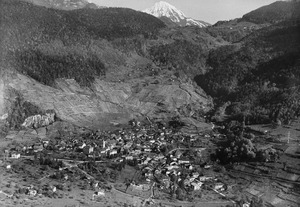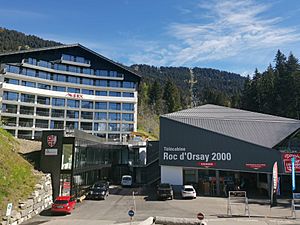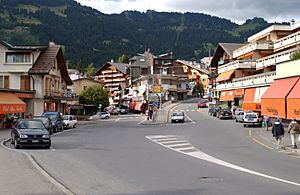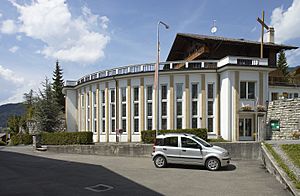Ollon facts for kids
Quick facts for kids
Ollon
|
||
|---|---|---|
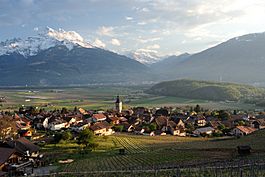
Ollon village with vineyards in the foreground and the Dents du Midi in background
|
||
|
||
| Country | Switzerland | |
| Canton | Vaud | |
| District | Aigle | |
| Area | ||
| • Total | 59.56 km2 (23.00 sq mi) | |
| Elevation | 479 m (1,572 ft) | |
| Population
(Dec 2020 )
|
||
| • Total | 7,624 | |
| • Density | 128.005/km2 (331.53/sq mi) | |
| Postal code |
1867
|
|
| Localities | Antagnes, Arveyes, Auliens, Bretaye, Chesieres, Crettaz, Exergillod, Forchex, Glutieres, Huemoz, Les Combes, Les Ecovets, Les Fontaines, Pallueyres, Panex, Plambuit, Plan d'Essert, Salaz, St-Triphon, Verschiez, Villars-sur-Ollon, Villy | |
| Surrounded by | Aigle, Bex, Collombey-Muraz (VS), Gryon, Monthey (VS), Ormont-Dessous, Ormont-Dessus | |
Ollon is a town, also called a municipality, located in the Aigle area of the canton of Vaud in Switzerland. It sits at the bottom of the mountains, southeast of Lake Geneva. The old German name for Ollon, Olun, is not used anymore.
Contents
History of Ollon
Ollon was first mentioned in records in 1018 as Aulonum. However, some people think this might have been a different place. Later, between 1025 and 1032, it was definitely called Olonum.
Saint-Triphon Village History
The village of Saint-Triphon is built on three hills. These hills look out over the Rhone valley. It was first written about in 1332 as Triphonis Sancti.
Archaeologists have found many old things here. These finds date from the Middle Neolithic period (New Stone Age) to the Roman times. They include an early Bronze Age necropolis (a burial ground) and a late Bronze Age smelter. A smelter is a place where metal, like copper, is melted down to make new things.
On a hill called Le Lessus, there is an 18-meter (59 ft) tall square tower. It was likely built in the 13th century. Parts of the tower were destroyed in 1476. Old foundations show that people reached the tower using a walkway. Close by, you can still see parts of a Romanesque chapel from the 12th century.
In 1232, the Counts of Savoy gave control of the castle to Guy de Saillon. A fief is like a piece of land given by a lord in exchange for loyalty. This fief was later divided in the 14th century. It was brought back together in the 16th century under the Rovéréa family.
Between 1476 and 1798, Saint-Triphon was one of the twelve Zenden des Mandements Ollon. This was a special administrative area under the government of Aigle. The village was ruled by a mayor from Bern. Since the Middle Ages, black marble has been mined in Saint-Triphon.
Geography of Ollon
Ollon covers an area of about 59.54 square kilometers (23 sq mi). As of 2009, a large part of this land is used for farming (40.1%). Another big part (45.5%) is covered by forests. About 10.6% of the land has buildings or roads. A small amount (0.9%) is rivers or lakes. The remaining 2.8% is land that cannot be used for farming or building.
Most of the built-up area (5.6%) is for homes and other buildings. Roads and other transport areas make up 3.1%. In the forested areas, 38.9% is dense forest. Another 4.8% has orchards or small groups of trees. For farming, 11.1% of the land grows crops. 8.5% is used for pastures where animals graze. Vineyards and orchards make up 2.9%, and alpine pastures are 17.7%.
The municipality is in the Aigle district. Ollon is next to the Rhône River on its southwest side. It stretches up the mountainside to a peak called Chamossaire. Ollon has 123 hectares (300 acres) of vineyards. It is one of the largest municipalities in its canton.
Ollon includes the main village of Ollon. It also has 23 other villages and small settlements called hamlets. Some of these are Antagnes, Arveyes, Chesières, Huémoz, Panex, Saint-Triphon, and Villars-sur-Ollon. There are also summer grazing camps like Bretaye.
Population and People in Ollon
Ollon has a population of about 7,000 people. As of 2008, about 32.7% of the people living in Ollon were foreign nationals. This means they were not Swiss citizens. Over ten years (1999–2009), the population grew by 11.7%. Most of this growth (10.7%) was due to people moving into Ollon. The rest (1.2%) was from more births than deaths.
Most people in Ollon speak French (79.2%). English is the second most common language (5.4%). German is third (3.9%). A smaller number of people speak Italian or Romansh.
In 2000, about 27.6% of the people living in Ollon were born there. Another 22.0% were born in the same canton (Vaud). About 16.2% were born elsewhere in Switzerland. The remaining 29.9% were born outside of Switzerland.
In 2008, the total population of Ollon grew by 2.8%. This growth was due to both Swiss and non-Swiss people moving into the area.
The age groups in Ollon, as of 2009, show that about 9.9% of the population are children aged 0-9. Teenagers (10-19) make up 19.7%. Adults aged 20-59 make up a large part of the population. Older adults (60 and above) make up about 20.9% of the population.
In 2000, about 27.6% of people in Ollon were single and had never been married. About 46.6% were married. The rest were widowed or divorced.
There were about 2,399 private homes in Ollon in 2000. On average, there were 2.3 people living in each home. About 33.3% of homes had only one person. There were 151 homes with five or more people.
In 2000, there were 5,227 apartments in Ollon. The most common size was 3 rooms. About 40.7% of these apartments were lived in all year. However, 55.1% were used only for part of the year, like for holidays. About 4.2% of apartments were empty. In 2010, about 1.33% of homes were empty.
The chart below shows how the population of Ollon has changed over time:

Important Heritage Sites
The area known as Saint-Triphon Et Charpigny is a very old settlement. It has remains from prehistoric times all the way to the Middle Ages. This site is listed as a Swiss heritage site of national significance. This means it's very important to Switzerland's history and culture.
Also, the entire villages of Huémoz and Ollon are part of the Inventory of Swiss Heritage Sites. This means they are recognized for their special historical and cultural value.
Economy of Ollon
In 2010, Ollon had an unemployment rate of 3.7%. This means that 3.7% of people who wanted to work could not find a job.
As of 2008, people in Ollon worked in different types of jobs:
- Primary sector: 221 people worked in this sector. This includes jobs like farming, fishing, and forestry. There were about 75 businesses in this area.
- Secondary sector: 287 people worked here. This sector includes jobs in manufacturing (making things) and construction (building things). There were 54 businesses.
- Tertiary sector: 1,588 people worked in this sector. This is the service sector, including jobs like retail, hotels, education, and healthcare. There were 227 businesses.
In total, 2,815 people living in Ollon had jobs. About 43.4% of these workers were women.
Many people travel for work. In 2000, 499 workers came into Ollon for their jobs. However, 1,334 workers left Ollon to work in other places. This means more people leave Ollon for work than come in. About 10.5% of workers used public transportation to get to work. Most people (59.5%) used a private car.
Religion in Ollon
Based on the 2000 census, about 30.7% of the people in Ollon were Roman Catholic. About 41.6% belonged to the Swiss Reformed Church.
Other religions present included Orthodox Christians (2.05%), Christian Catholic Church (0.05%), and other Christian churches (2.67%). There were also people who were Jewish (0.22%) and Islamic (2.80%). A small number of people were Buddhist, Hindu, or belonged to other faiths.
About 11.70% of the population said they did not belong to any church. They might be agnostic (not sure if God exists) or atheist (do not believe in God). About 7.67% of people did not answer the question about their religion.
Education in Ollon
In Ollon, about 31.6% of the population has finished upper secondary education. This is education after primary school but before university. Also, 14.1% have completed higher education. This means they went to a university or a Fachhochschule (a type of professional university).
In the 2009/2010 school year, there were 789 students in the Ollon school district. In the Vaud canton, two years of optional pre-school are offered. During that year, 205 children attended pre-school.
The canton's primary school program lasts for four years. There were 402 students in primary schools in Ollon. The required lower secondary school program lasts for six years. There were 386 students in these schools. A few students (1) were homeschooled or went to other non-traditional schools.
In 2000, 46 students came to Ollon schools from other towns. However, 346 students from Ollon went to schools outside the municipality.
See also
 In Spanish: Ollon para niños
In Spanish: Ollon para niños






